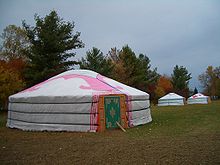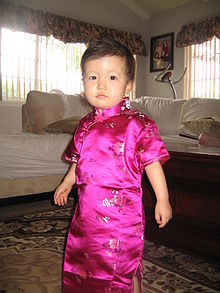- Mongolian American
-
Mongolian Americans Total population 15,000-18,000[1] Regions with significant populations  California
California3,000 [2]  Virginia
Virginia2,600 [1]  Colorado
Colorado2,000 [3]  Illinois
Illinois4,000 [4] Languages Religion Related ethnic groups Mongolian Americans are immigrants from Mongolia to the United States and their descendants. The term Mongol American is also used to include ethnic Mongol immigrants from groups outside of Mongolia as well, such as Kalmyks, Buryats, and people from the Inner Mongolia autonomous region of China.[citation needed] Some immigrants came from Mongolia to the United States as early as 1949, spurred by religious persecution in their homeland.[6] However, Mongolian American communities today are composed largely of migrants who arrived in the 1990s and 2000s, as communism in Mongolia came to an end and restrictions on emigration lifted.[4]
Contents
Migration history and distribution
The Denver metropolitan area was one of the early focal points for the new wave of Mongolian immigrants.[5] Other communities formed by recent Mongolian immigrants include those in Chicago, San Francisco, and Washington, D.C.[4]
Colorado
The Mongolian community in Denver traces its roots back to 1989, when Djab Burchinow, a Kalmyk American engineer, arranged for three junior engineers from Mongolia to study at the Colorado School of Mines. They were followed by four further students the following year; in 1991, Burchinow also began to urge the Economics Institute at the University of Colorado to admit Mongolian international students as well. By 1996, the University of Colorado's Denver campus had set up a program specifically aimed at bringing Mongolian students to Colorado. The growth in the number of students coincided with an economic boom and a labor shortage in the Denver area; as a result, many Mongolian students in Colorado chose to stay in the state after their graduation. However, a significant number went back to Mongolia as well, to the extent that in 2003 they formed an association of students returned from Colorado. Their influence is seen in other ways as well; there were said to be plans to change the name of the Ulan Bator street on which the United States embassy sits to "Denver Place".[5] As of 2006[update], Colorado's Mongolian American population was believed to be roughly 2,000 people, according to the director of a community-run Mongolian language school set up by local parents worried about the increasing Americanization of their children.[3]
California
As many as 3,000 Mongolian immigrants are estimated to live in the San Francisco Bay Area's East Bay cities of Oakland and San Leandro; they began settling in the area only after 2002, and as a result their presence was not reflected at all in the 2000 Census. Many live in predominantly Chinese American and Vietnamese American neighborhoods; tensions arose between the newcomers and the established immigrant communities, and some fights among Mongolian American and other Asian American youths have broken out as a result.[2] In one major incident, a Mongolian immigrant girl was shot dead in a confrontation between Southeast Asian and Mongolian youths in an Alameda park on Halloween night in 2007.[7][8] Four members of the former group were convicted of first-degree murder: three of the boys were tried in juvenile court and sentenced to seven years in prison in 2008, while the shooter was tried as an adult and sentenced to 50 years to life in state prison in 2010.[9][10]
There is also a Mongolian immigrant population in Los Angeles, estimated at about 2,000 people as of 2005[update], according to local community leader Batbold Galsansanjaa. They have close ties to the city's Korean American community: most community members live and work in Koreatown. A Korean who had previously worked in Mongolia as a Christian missionary established Los Angeles' only Mongolian-speaking church in Koreatown, while a Mongolian Buddhist congregation gathers for worship at the nearby Korean Buddhist Kwan-Um Temple.[11]
Virginia
The Mongolian embassy to the United States estimated Arlington, Virginia's Mongolian population at 2,600 as of 2006[update]; they were reportedly attracted to the area by the high quality of education. As a result of their presence, Mongolian has become the local school system's third-most widely-spoken language, after English and Spanish; 219 students of Mongolian background are enrolled in the local school system, making up 1.2% of all students, but often forming a majority in ESL classes. Members of the first generation largely come from university-educated backgrounds in Mongolia, but work at jobs far beneath their qualifications after moving to the United States. Community institutions include an annual children's festival and a weekly newspaper.[1]
Illinois
Chicago's Mongolian American community is estimated at between 3000 and 4000 people by local leaders; they are geographically dispersed but possess well-organized mutual support networks. Some have established small businesses, while others work in trades and services, including construction, cleaning, housekeeping and food service.[4] In 2004, Lama Tsedendamba Chilkhaasuren, an expatriate from Mongolia, came to the Chicago area for a planned stay of one year in an effort to build a temple for the area's Mongolian Buddhist community.[12]
Demographics
 On the grounds of Tibetan Mongolian Buddhist Cultural Center in Bloomington, Indiana
On the grounds of Tibetan Mongolian Buddhist Cultural Center in Bloomington, Indiana
60% of Mongolians residing in the United States entered the country on student visas, 34% on tourist visas, and only 3% on working visas. 47% live with their family members. The majority are believed to be staying in the country illegally. The Mongolian Embassy estimates that, up to 2007, only 300 babies have been born to Mongolian parents in the United States. Interest in migration to the United States remains high due to unemployment and low income levels in Mongolia; every day, fifty to seventy Mongolians attend visa interviews at the United States embassy in Ulan Bator.[13] Since 1986, only 1,646 Mongolians have become legal permanent residents of the United States, although 1,338 of those were just in the years 2002–2006, and the numbers are growing rapidly.[citation needed]
Mongol-American Cultural Association
Mongolian-American child wearing traditional Mongolian deel
The Mongol-American Cultural Association (MACA) was created to preserve and promote Mongol culture in the United States. MACA understands the term Mongol to be inclusive of the people and cultures of all regions where Mongol groups have traditionally lived; in addition to Mongolia, it includes the people and cultures of Kalmykia, Buryatia, Tuva and the Mongol regions of China. MACA was founded in 1987 by the late Professor Gombojab Hangin, Indiana University, and Tsorj Lama, former Abbot of the Qorgho Monastery in Western Sunid, Southern Mongolia. Since the death of Professor Hangin in 1989, and of Tsorj Lama in 1991, their students have carried on the work they started, as board members Tsagaan Baatar, Chinggeltu Borjiged, Enghe Chimood, Thomas Yang, Tony Ettinger, Palgi Gyamcho and Sanj Altan. MACA was formally incorporated as a 501C3 non-profit organization in 1992.
MACA also pursues a humanitarian program. In 1994, MACA sent $10,000 worth of insulin to Mongolia. MACA was an early supporter of the Peace Corps programs in Mongolia with their English language instructional materials needs. In 1995, MACA established the Mongolian-Children's Aid and Development Fund (MCADF) which functioned as the fund raising and executive arm of the various humanitarian initiatives aimed at providing aid to Mongolian children. Former Secretary of State James A. Baker III serves as honorary chairman of the advisory board to the MCADF. The MCADF has provided nutritional aid and clothing to orphanages and provided small stipends to selected orphans. Since 2004, the MCADF has entered into a sponsorship of the Night Clinic operated by the Christina Noble Foundation, which provides medical services to the street children of Ulaanbaatar. MACA is a primary sponsor of the Injannashi Fund, which provides small educational grants to students in Southern Mongolia. MACA also provides small grants from time to time to cultural and educational institutions to support cultural events related to the Mongolias.
MACA holds a Chinggis Qan ceremony annually, a continuation of the cult of Chinggis Qan, held in the Ezen Qoroo region of Ordos. This ritual was started in the United States by teachers Gombojab Hangin and C'orj'i Lama in 1988, and is held annually in late fall. In 1999, to mark the 10th anniversary of the death of Professor Gombojab Hangin, a Chinggis Qan Symposium was held in his memory, which resulted in the publication of the proceedings with articles from scholars from Mongolia, Southern Mongolia, Buryatia and Kalmykia.
MACA is open to all individuals who share a common belief in the importance of preserving Mongol culture in the United States.
See also
References
- ^ a b c Bahrampour, Tara (2006-07-03), "Mongolians Meld Old, New In Making Arlington Home", The Washington Post, http://www.washingtonpost.com/wp-dyn/content/article/2006/07/02/AR2006070200875.html, retrieved 2007-09-05
- ^ a b Murphy, Kate (2007-04-06), "Recreation center plans party to bridge ethnic gap; Chinese-American attacked by Mongolian youths in Oakland's Chinatown", Oakland Tribune, http://www.insidebayarea.com/ci_5607604, retrieved 2011-03-19
- ^ a b Lowrey, Brandon (2006-08-13), "Keeping heritage in mind", Denver Post, http://www.denverpost.com/news/ci_4175100, retrieved 2007-09-05
- ^ a b c d e Steffe, Tracy (2005), "Mongolians", The Electronic Encyclopedia of Chicago, Chicago Historical Society, http://www.encyclopedia.chicagohistory.org/pages/838.html, retrieved 2007-09-05
- ^ a b c Cayton-Holland, Adam (2006-07-06), "Among the Mongols: Steppe by steppe, the hordes are descending on Denver", Denver Westword News, http://www.westword.com/2006-07-06/news/among-the-mongols/full, retrieved 2007-09-17
- ^ a b c Ts., Baatar (1999), "Social and cultural change in the Mongol-American community", Anthropology of East Europe Review 17 (2), http://condor.depaul.edu/~rrotenbe/aeer/v17n2/Baatar.pdf
- ^ Albert, Mark (2008-06-27), "One Shooter or Two in Iko Slaying? Prosecution stumbles over witness testimony", Alameda Sun, http://alamedasun.com/index.php?option=com_content&task=view&id=3519&Itemid=10, retrieved 2011-03-19
- ^ Lee, Min (2007-12-18), "Police Accused of Racial Profiling in Alameda Murder Investigation", New American Media, http://news.newamericamedia.org/news/view_article.html?article_id=230ff69c4033c4690685936cd5a17db3, retrieved 2011-03-19
- ^ Lee, Henry K. (2008-01-26), "3 boys sentenced in Alameda Halloween killing", San Francisco Chronicle, http://www.sfgate.com/cgi-bin/article.cgi?f=/c/a/2008/01/26/BABPULS5R.DTL, retrieved 2011-03-19
- ^ "Gunman Sentenced In Alameda Teen Halloween Slaying", KTVU News, 2010-08-20, http://www.ktvu.com/news/24703563/detail.html, retrieved 2011-03-19
- ^ Tang, K. Connie (2005-11-26), "L.A.'s Christian Mongolians Find Home at Church", Los Angeles Times, http://articles.latimes.com/2005/nov/26/local/me-belief26, retrieved 2011-03-19
- ^ Avila, Oscar (2004-03-19), "Buddhist priest lights way: City's Mongolians aim to form temple, cultural identity", Chicago Tribune, http://articles.chicagotribune.com/2004-03-19/news/0403190048_1_local-temple-chicago-mongolian-people, retrieved 2011-03-19
- ^ Solongo, Algaa (25 May 2007), "Growth of Internal and International Migration in Mongolia", 8th International Conference of Asia Pacific Migration Research Network, Fujian, China: Fujian Normal University, http://apmrn.anu.edu.au/conferences/8thAPMRNconference/6.Sologo.pdf
External links
- Mongol American Cultural Association
- Mongolian Immigrant Tries to Find New Life, 1991 article in The New York Times about a homeless Mongolian immigrant in New York
Asian Americans East Asian 
South Asian2 Southeast Asian Burmese · Cambodian · Filipino · Hmong · Indonesian · Laotian · Laotian Chinese · Mien · Singaporean · Thai · VietnameseOther History 1 The US Census Bureau reclassifies anyone identifying as "Tibetan American" as "Chinese American". [1].
2 The US Census Bureau considers Afghanistan a South Asian country, but does not classify Afghan Americans as Asian. [2]Categories:- American people of Mongolian descent
- Mongolian culture
Wikimedia Foundation. 2010.

